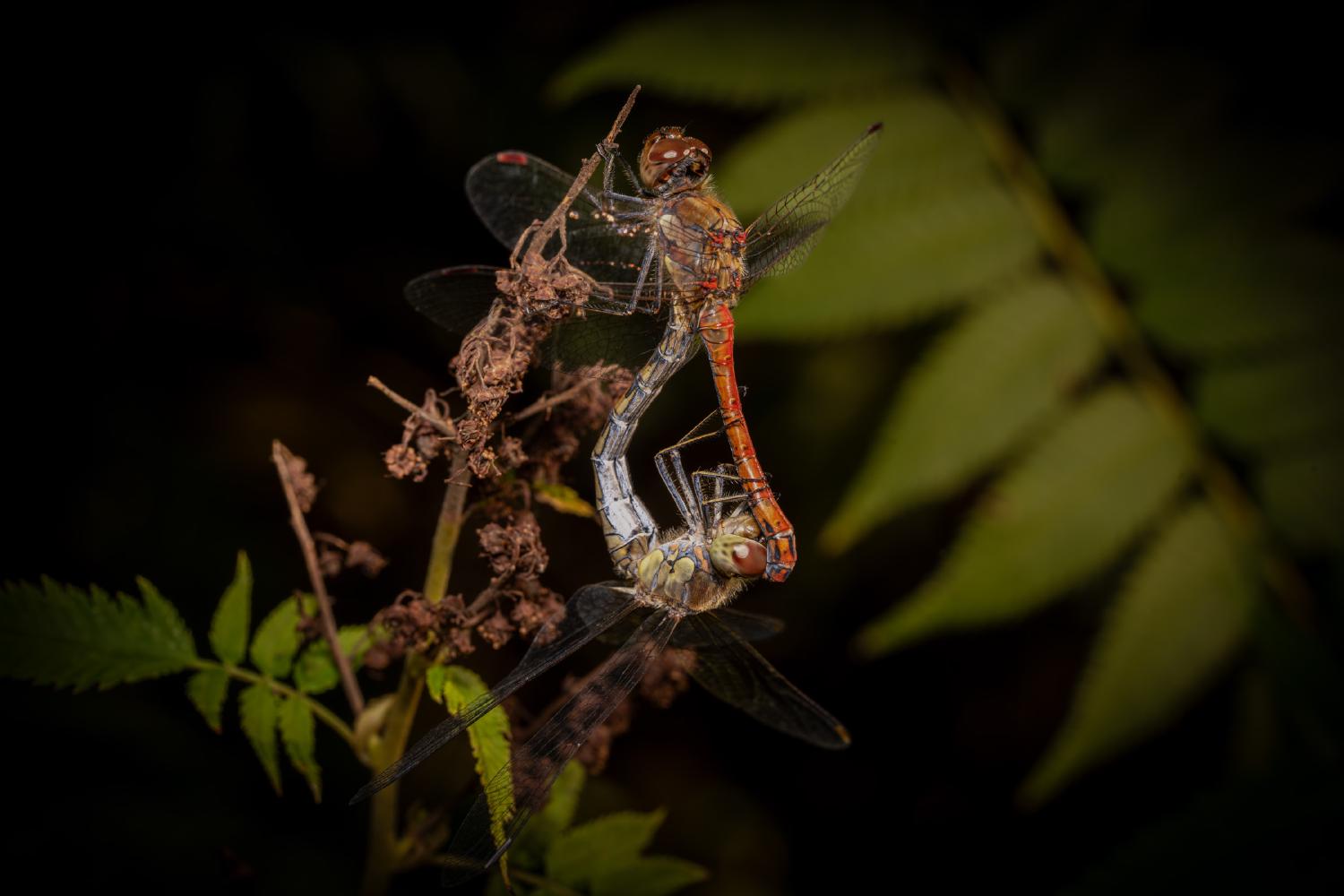Dragonflies and Damselflies
Lat. “Odonata“
order
of class
“Insects“
1 order, 2 suborders, 6 species
The term Odonata was coined by Johan Christian Fabricius in 1793, derived from the Ancient Greek term for ’tooth’, possibly due to their toothed maxillae. The word “dragonfly” generally refers to Anisoptera, but is sometimes used to encompass all Odonata. Odonates are aquatic or semi-aquatic as juveniles and have a carnivorous diet throughout their life, feeding mostly on smaller insects. They play a role as bioindicators of water quality and are sensitive to changes in temperature. With increased global temperature, changes in their life cycle and hybridization between species are observed. Their fossil record and complete evolutionary history make them an ideal species for studying insect evolution and adaptation.
Hierarchy
Etymology and terminology
Johan Christian Fabricius coined the term Odonata in 1793 from the Ancient Greek ὀδών odṓn (Ionic form of ὀδούς odoús) ’tooth’. One hypothesis is that it was because their maxillae are notably toothed.The word dragonfly usually denotes only Anisoptera, but is sometimes used to mean all Odonata. Odonata enthusiasts avoid ambiguity by using the term true dragonfly, or simply anisopteran, when they mean just the Anisoptera. An alternative term warriorfly has been proposed.
Ecology and life cycle
Odonates are aquatic or semi-aquatic as juveniles. Thus, adults are most often seen near bodies of water and are frequently described as aquatic insects. However, many species range far from water. They are carnivorous (or more specifically insectivorous) throughout their life, mostly feeding on smaller insects.Male Odonata have complex genitalia, different from those found in other insects. These include grasping cerci at the tip of the abdomen for holding the female, and a secondary set of copulatory organs located between the second and third abdominal segment in which the spermatozoa are stored after being produced by the primary genitals— whose external opening is known as the genital pore, on the ninth abdominal segment. This process is called intra-male sperm translocation (ST). Because the male copulatory organ has evolved independently from that in other insects, it has been suggested the stem-group dragonflies had external sperm transfer. To mate, the male claspers grasps the female by the thorax (Zygoptera) or head (Anisoptera) while the female bends her abdomen so that her own genitalia can be grasped by the copulatory organ holding the sperm. This is known as the “wheel” position.Eggs are laid in water or on vegetation near water or wet places, and hatch to produce pronymphs which live off the nutrients that were in the egg. They then develop into instars with approximately 9–14 molts that are (in most species) voracious predators on other aquatic organisms, including small fishes. The nymphs grow and molt, usually in dusk or dawn, into the flying teneral immature adults, whose color is not yet developed. These transform into reproductive adults.Odonates can act as bioindicators of water quality in rivers because they rely on high quality water for proper development in early life. Since their diet consists entirely of insects, odonate density is directly proportional to the population of prey, and their abundance indicates the abundance of prey in the examined ecosystem. Species richness of vascular plants has also been positively correlated with the species richness of dragonflies in a given habitat. This means that in a location such as a lake, if one finds a wide variety of odonates, then a similarly wide variety of plants should also be present. This correlation is not common to all bioindicators, as some may act as indicators for a different environmental factor, such as the pool frog acting as a bioindicator of water quality due to its high quantity of time spent in and around water.In addition, odonates are very sensitive to changes to average temperature. Many species have moved to higher elevations and latitudes as global temperature rises and habitats dry out. Changes to the life cycle have been recorded with increased development of the instar stages and smaller adult body size as the average temperature increases. As the territory of many species starts to overlap, the rate hybridization of species that normally do not come in contact is increasing. If global climate change continues many members of Odonata will start to disappear. Because odonates are such an old order and have such a complete fossil record they are an ideal species to study insect evolution and adaptation. For example, they are one of the first insects to develop flight and it is likely that this trait only evolved once in insects, looking at how flight works in odonates, the rest of flight can be mapped out.
See also
Lists of Odonata species of Australia - Britain - Canada (dragonflies | damselflies) - Estonia - Finland - France - India - Ireland - Slovenia - South Africa - Sri Lanka - Taiwan
External links
Anatomy of Odonata dragonflies and damselflies on the UF / IFAS Featured Creatures Web site Dragonflies and Damselflies (Odonata) of the United States – USGS state-by-state listing with distribution maps, images International Journal of Odonatology IORI species list, photos, social media links Archived 2007-05-29 at the Wayback Machine Journal of the Entomological Research Society Odonata Central Odonatologica World Odonata List Worldwide Dragonfly Association
Ancestry Graph
Further Information
Copyright

This article uses material from the Wikipedia article Odonata the free encyclopedia Wikipedia which is released under Creative Commons Attribution-ShareAlike 4.0 International License). On Wikipedia a list of authors is available.
